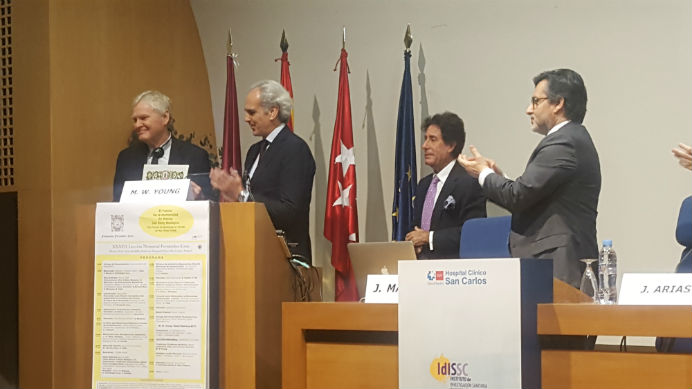
The first indication of the existence of a biological clock could be traced to the plant Mirabilis, whose leaves open towards the sun by day and close at nightfall. Applied to the human being, these fluctuations manifest in what is known as the circadian rhythm. This is the analogy that Dr. Michael W. Young, 2017 Nobel Prize in Medicine and protagonist of the 37 Fernández-Cruz Memorial Lesson, has used to open his lecture. The Practicum Foundation has attended the meeting held at the Hospital Clínico San Carlos in Madrid to learn about the latest contributions in the field of chronobiology.
Madrid – June 19, 2018. Life on Earth adjusts to the rotation of the planet; in parallel, the schedules of our organism are defined by the hands of our internal clock. This clock adjusts our physiology to the phases of the day and regulates critical functions, such as behavior, hormonal levels, sleep, body temperature, and metabolism. Hence, the chronic mismatch between lifestyle and the rhythm that marks the internal chronometer is associated with an increased risk of mental disorders, changes in brain function, diabetes, and even some types of cancer. The Nobel Prize in Medicine Michael W. Young has spoken about all of this in a meeting that has taken place in the Hospital Clínico San Carlos, at the Spanish capital.
Invited by the Fernández-Cruz Foundation, which has awarded him the 37 Memorial Lesson, the American biologist and geneticist has underlined that "one in every seventy-five Europeans is a carrier of a genetic mutation responsible for sleep problems." His intervention has focused on circadian sleep disorders and has exposed the genetic mechanism that winds up the clock. In 1984, Dr. Young identified the gene period in fruit flies and later found out how the PER protein, whose levels oscillate throughout the day in synchrony with the circadian rhythm, influences its activity. Specifically, "the period gene is one of those that control the existence of locomotor rhythms." Thus, under constant external conditions, such as absolute darkness, the insect would follow a 12-hour movement pattern (remaining still over the next 12 hours), and a mutation could lengthen, shorten, or abrogate these cycles.
The origins of these rhythms, which had already been detected in the opening and closing of the leaves of some plants, had been sought since the 18th century. Dr. Young's work at the Rockefeller University in the United States was the trigger for research on the oscillations of biological variables in 24-hour intervals, which would soon jump from flies to mice and humans. From his findings, the scientific community has confirmed the entity of this clock that regulates sleep, dietary patterns, body temperature, and even the release of hormones. "You have to think that we have organs that are going to pay attention to meal times, but they are also going to be aware of the sunlight," so, for example, when traveling through different time zones and facing jet lag, Dr. Young recommends "taking a nap and engaging during the hours of daylight in the destination.”
Sleeping little shortens life
In the same vein, the 69-year-old professor has referred to night shift work. In these cases, he recommends ensuring enough light, so the absence of the sun in the workplace is not noticed." In general, people are programmed to sleep at night and be awake during the day. That is why those who work in shifts, lie down glued to screens, or continually change their time zones are altering their circadian rhythm and, in the long term, can experience serious health problems. "We know that life expectancy is shortened if a minimum number of hours of sleep is not respected," said Dr. Young. On the other hand, "it is true that some people are early birds and some others are night owls, and being aware of our place could trigger productivity."
"Sleep disorders are already considered as a toxic risk factor," said the president of the convening foundation, Arturo Fernández-Cruz. In his opinion, aging is a complex and irreversible process, but there are different ways of aging. That is, the biological clock has plasticity when it comes to programming life’s ceiling. "Everything that happens around us influences us. Each cell suffers ten thousand injuries per day, but we have protection mechanisms, such as telomeres. Medicine is no longer precise; it is hyper-precise. And thanks to that, I think it is possible for longevity to be increased and, why not, for death to become someday an anecdote, "added Dr. Fernández-Cruz.
Setting up the machinery time
Our well-being is in danger when a mismatch occurs between the external environment and the internal biological clock. A simple solution is to try to make the stimuli as regular as possible, adapting the time of the meal or exercise," said Dr. Young. In general, the speed of the 21st century is worsening sleep quality, leading to endocrine, psychological, and immunological complications, as well as affecting cognitive performance and increasing the risk of hypertension and stroke. Recently, the Northwestern University in Illinois (USA) pointed out that our internal clock is able to mark how and when the pancreas has to produce insulin. Other studies have linked low-grade chronic inflammation (associated, among others, with lack of restful sleep) with cancer. These examples reinforce the idea that "clocks that work in cells are essential for health," finalized Dr. Young.
Our personalized help center enables you to obtain technical support and help for navigating through the site and using the program.